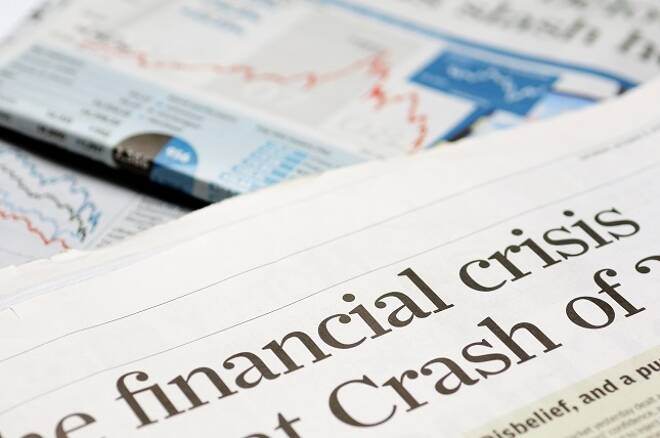Advertisement
Advertisement
If History Repeats Itself – The Next Financial Crisis is Around the Corner
Updated: Mar 4, 2019, 13:22 GMT+00:00
The annals of history are ridden with examples of humans failing to learn from past mistakes. As a matter of fact, certain events repeat themselves so similarly that history is literally said to repeat itself. One such phenomenon is financial crises and recessions.
From the great depression in the 30’s to the meltdown about a decade ago, certain trends are noticeable. With a new President and uncertainties about his economic policy, many are worried that the next financial crisis might be around the corner. It goes without saying that policy mistakes are most times at fault for causing or worsening some of these crises.
Indeed, it may be true that as for now there is a steady rise in stock markets and many remain confident. However, the task of being on the lookout for the next crisis is as important as any investment decision. There are some market analysts who warned of the crash back in 2007 but were ignored.
The role of policy
The answers economists and financial analysts give on financial stability are often hinged on political affiliation. Centre and left-leaning economists, for instance, will always point at lax regulation in the lead up to crashes. The 2008 meltdown was triggered by the housing market collapse due to poor lending practices by banks.
Therefore, such economists will look at President Trump’s rollback of most of the post-recession regulations as a precursor to disaster. The less regulated banks are, the more likely they are to take risks and subsequently crises happen.
One notable example is Jihad Dahger, a researcher at IMF. He published a paper in 2017 titled: Revisiting the Political Economy of Financial Crises. In it, he analyzes what he calls the cyclical nature of regulations. The tough regulations that come after a crash don’t necessarily survive the next crash. Let’s look at the United States which is the largest economy in the world. It is often said that when America coughs, the rest of the world catches a cold.
The Chart below is an illustration of this fact. This is why it is prudent for policymakers in the USA to get it right since virtually the entire world is dependent on it.
On January 25, 2017, the Stock markets broke a record by eclipsing the 25,000 mark on the Dow Jones. The president signed an executive order in effect rolling back some of the key regulations under the Dodd-Frank legislation post-2009. This would in effect reduce regulations on banks and limit the powers of regulators. This is eerily similar to the repeal of the Glass-Steagall act in 2000. This piece of legislation came after the great depression had split investment from commercial banks. The rest is history.
That history could come full circle once again. Dahger, in his analysis, has pointed out these trends from the 18th century in the world’s major economies. The same can be seen is other economies like Japan and Spain which lifted regulations on their banks that had held for decades. Spain experienced a similar problem with the South Sea Bubble of the 2000s.
The risks are not inherently because of lax regulations. Rather, it is because markets and banks tend to take certain products and speculate on them to the widest stretch. Besides, certain trends could also emerge and the speculation on them leads to bubbles. Examples are the subprime loans during the housing bubble and the dot crash bubble of 2000. There are other external factors that come into play, including but not limited to political disputes.
Political disputes and instability
The recent standoff with North Korea and a looming trade war between the USA and China have reared their ugly head over the stock markets. The Dow Jones industrial average, for instance, lost hundreds of points in a few trading hours at the height of these tensions. Such disputes on a major scale have the potential to crash markets worldwide. This is because the financial world is literally a global village.
The integrity of political unions like European Union is something that is vital for economic stability. After Brexit and the rise of far-right movements in Europe, the fears of a financial crisis due to politics are not completely unfounded. China has also experienced a slowdown in growth to about 6 percent and this has the potential to slow overall global economic growth. China is the world’s factory and a decline in manufacturing there has the potential to a marginal rise in commodity prices everywhere.
‘Too Big To Fail’
A lot of the problem form the last recession still linger. In fact, some analysts contend that the next crisis was merely postponed rather than averted. This is because of the measures that were adopted failed to address some systemic problems. The biggest banks in the world are still too big to fail. Just five years after the 2008 crash, the four biggest banks had $7.8 trillion in assets equivalent to 47 percent of the US GDP up from 43 percent pre-recession.
The risk of this disproportionate power to few institutions needs no explanation. They have little accountability because the government has to bail them out in case of troubles. Other challenges such as student loans crisis and the income inequality in the developed world also have to be addressed.
Conclusion
It is difficult to pinpoint exactly when and how the next crisis will come about. That said, society would be foolish not to learn from past experiences and trends. The consequences of a financial crisis are dire. Let us be pro-active rather than reactive.
About the Author
Did you find this article useful?
Latest news and analysis
Advertisement
